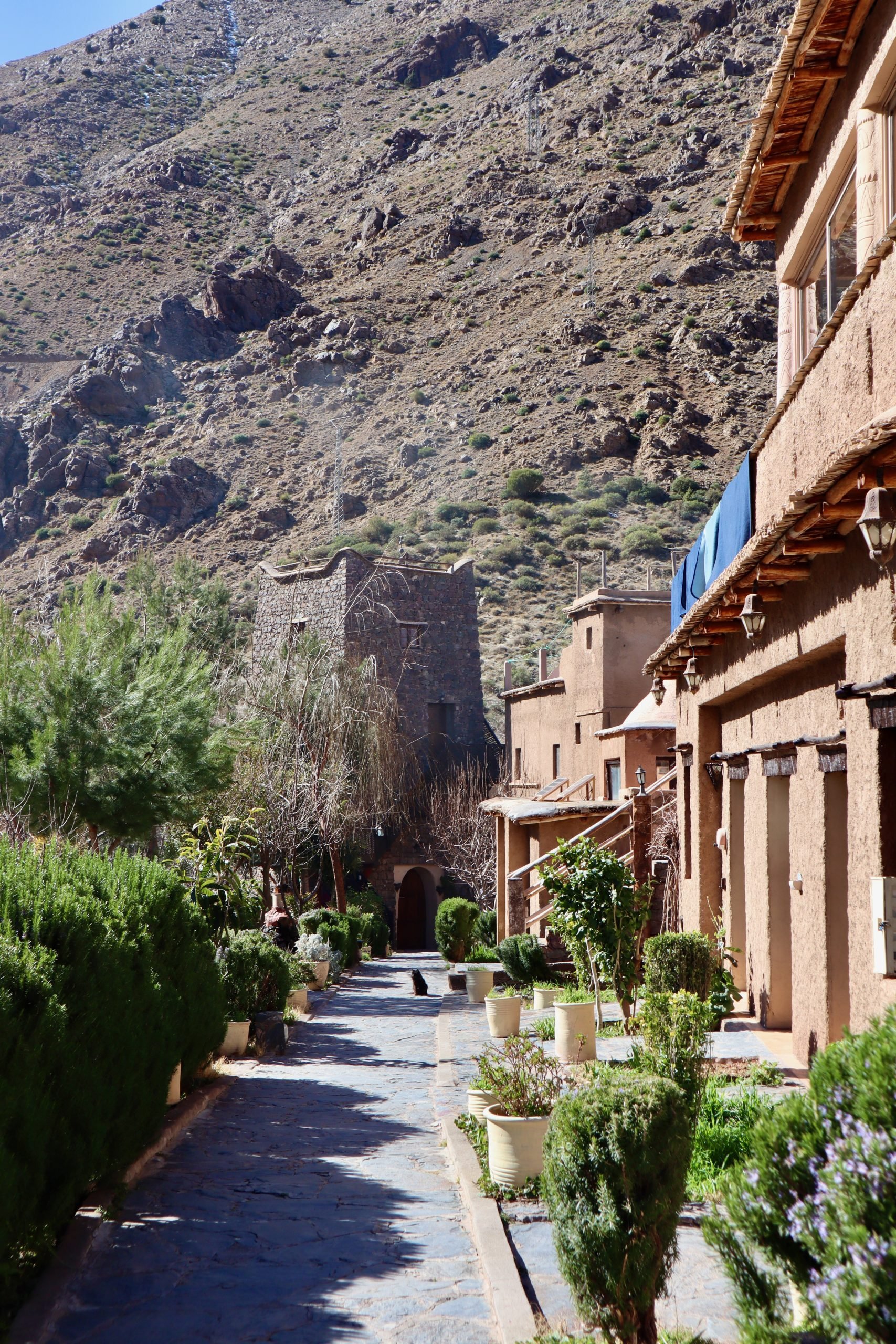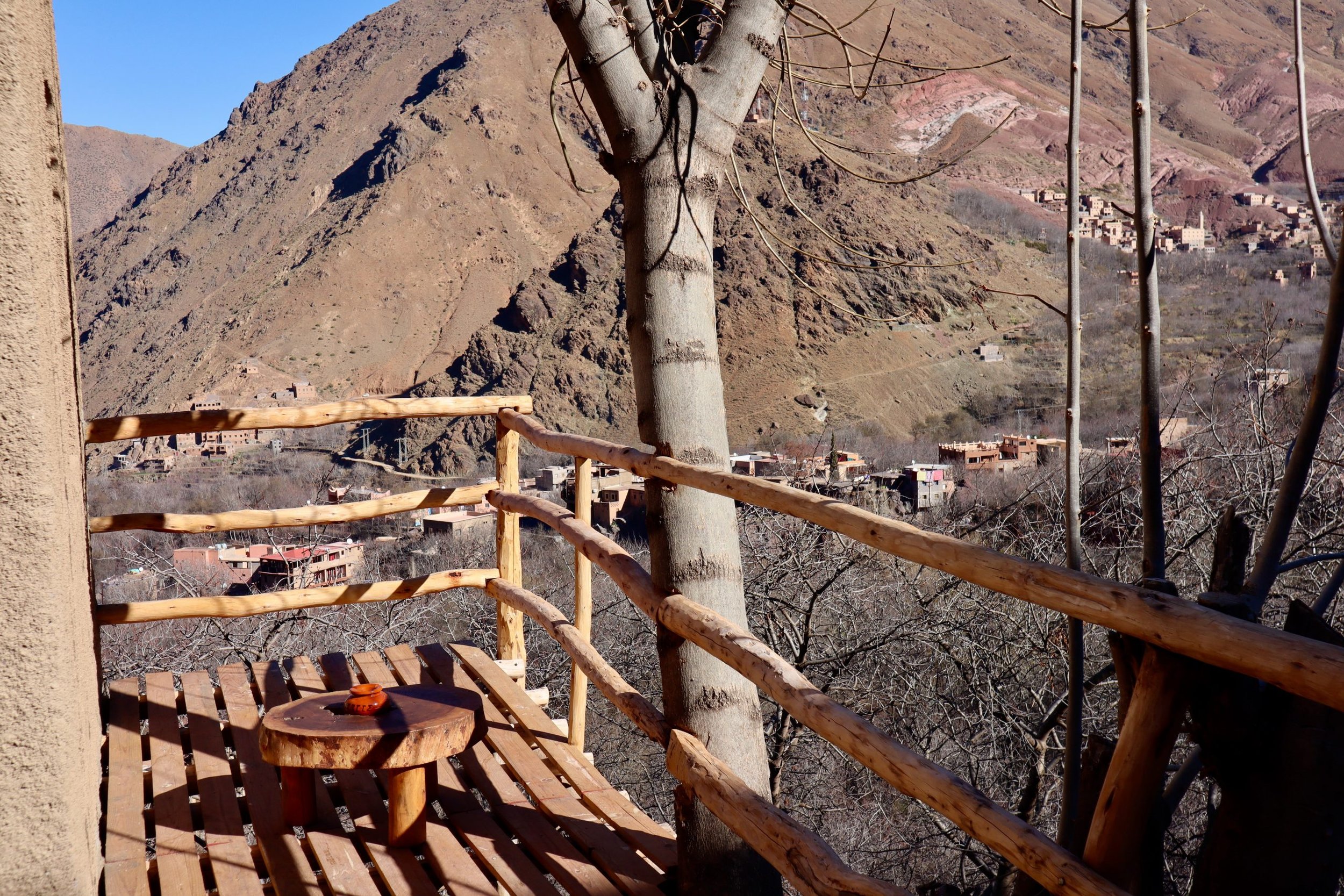Kasbah du Toubkal: A National Geographic World's Most Unique Lodge
The drive from the coast of Taghazout to the High Atlas Mountains took around 5 or 6 hours. Repetitive at first (it was backtracking our original route, going back through Marrakesh), but dramatic by the end with beautiful views of the snowcapped mountains and treacherous one-way sized roads on the edge of a cliff. We were headed to the Kasbah du Toubkal, a National Geographic "one of the world's most unique lodges." A three-night stay at this remote lodge was a Christmas gift from my boss– she's known to give extravagant, generous, and extraordinary gifts. (Thank you Kyra!) That being said, we really didn't know what we were getting into, as we drove up the bumpy dirt road to a tiny rural village...The Kasbah is in the village of Imlil, known as the base of the High Atlas Mountains. Mount Toubkal is visible in the distance, and is the highest peak in North Africa. Imlil is a small village, just a few blocks total, with cobblestone roads winding up the hill and miscellaneous storefronts, snack shops and mostly "adventure gear" shops. This area is mostly popular with trekkers, hikers and backpackers- so it's mostly catering to the adventurous travelers, complete with super cheap hostel options. The Kasbah du Toubkal is sort of the gem of the area– a world renown lodge with a storied history. Below is the blurb about the Kasbah on the National Geographic unique lodge list:
In 1989, two British brothers were visiting a Berber mountain guide in Morocco’s High Atlas Mountains, when they set their sights on a ruined Kasbah perched on a hilltop against the soaring backdrop of the tallest mountain in North Africa. Together with their Moroccan host, they pursued a vision of establishing a retreat on the edge of Toubkal National Park that would make these mountains—and the culture of their inhabitants—accessible to those who wished to explore them. The lodge they created has evolved into one of the most authentic and treasured destinations in Morocco, a tribute to Berber tradition and hospitality that welcomes hikers seeking a cozy mountain refuge, groups in need of an inspiring and stunning venue to gather, and travelers looking for a deeply meaningful cultural experience.
I read up on the check-in and arrival instructions religiously, because we don't have international data so unless we have access to wi-fi we're completely offline. I'm always super specific and detailed when planning arriving at a new location, because if we get lost or can't find the entry directions (like at an Airbnb, for example) then we're stuck– we can't just call the host and say "I'm here!" So in my research (and the handy arrival guide the Kasbah sent us beforehand), I learned that we had to check-in to the Kasbah in the tiny village at a reception area, and then actually hike up to the Kasbah property. The reception area wasn't entirely clear at first, we actually drove right by it and took a wrong turn, ended up on a one-way hill and the locals had to help us reverse back down safely. They could tell we were headed for the Kasbah, it's probably a common mistake and they quickly showed us in the right direction to the check-in reception.
Check in (once we found it) was super smooth, and we were pleased to learn our baggage would be carried up to the lodge by mule! The hike is about 1 mile, perhaps a bit longer, and all uphill on a dirt trail and some cobblestone steps. The steep incline combined with being at 4,300 ft elevation- I was pretty winded and very happy to have the mule assistance!!
Upon arriving to the actual lobby, we were greeted with the signature Moroccan mint tea and dates with milk. We were briefly shown around the lobby and dining area (see above), where dinner and breakfast would be served each day during specific hours. As we were resting in the lobby, a group of other guests were mingling in the sitting room, sharing wine and chatting. (Alcohol is not served here– or most places in Morocco, actually. But most of the Western-tourism places will allow you to bring your own, and will happily provide wine glasses, etc.).
The group of middle aged Americans were on a tour together, a 12 day exploration around Morocco– we learned tour groups visiting the Kasbah was quite common and people actually renting a car and driving up there themselves (like us) was more rare, since it's so remote.
The lodge grounds were well-kept and surrounded by beautiful views of the mountains. There were several different types of accommodation options from suite rooms (attached to the main lobby building), as well as a second building just across the courtyard that had a few townhouse-style options. These rooms were easily accessible on the grounds, but also not super private. All we knew about our accommodations (remember this was a gift) was that it was "three-night deluxe stay" with all meals included.
The receptionist took us around back to a steep zig-zag path of steps (with patches of snow on the ground!), passing cute little standalone huts sprinkled along the pathway. As we continued down the dozens if not hundreds of steps, I wondered which one he'd stop at and say we've arrived!, until we reached the end of the path and our little hut was the very last one!!
Pros: incredibly private, beautiful views, cute little balcony, no neighbors...
Con: it's a freaking hike back up the stairs to the lobby! Oh well, we really got our workouts in during this stay!
Our hut was super cute with beautiful Moroccan style. It had a kitchenette, complete with mini fridge and stovetop. An entire 'office' space, offering a wooden desk with a picturesque view. This beautiful sitting area with the handmade Moroccan chairs, a classic woven rug next to the wood burning stove. There was also a separate, spacious bedroom connecting to an ensuite bathroom– and luckily an electric heater in addition to the wood burning stove. (It was around 60º F during the day, dropping to mid 40s at night!! Hence the snow still on the ground!)
The lodge staff would come and tidy up our room each day as we were out exploring, and a pleasant surprise was that they build a fire for us each evening too! All we had to do is light it up :) They even turned on the electric heaters for us each afternoon so our bedroom was nice and toasty. So sweet!
The BEST part about the Kasbah du Toubkal was this amazing rooftop terrace above the lobby. Lunch was served up here each day, and it offered spectacular views! Most guests were out daytrekking and took the option of a packed lunch to bring along with them, so we often had the terrace all to ourselves for lunchtime!
Although pretty chilly in the shade, the rooftop offered a little hot pocket and the temperatures soared up here with the beating sun, which felt amazing! The gracious staff even offered straw hats upon seating you at your table.
We had already been in Morocco for two weeks (read about our first 12 nights in Taghazout here), so to be honest we were pretty over Moroccan food. It's delicious at first but lacks variety after the first week, let alone two weeks. That being said, the Kasbah du Toubkal had the best food of our whole stay! It would be the same meals (couscous and tagines, etc.) but it was more flavorful and fresh here. You could taste the thoughtfulness and traditional Berber hospitality behind each meal!
The Berber people are indigenous to North Africa, with their own unique languages, heritages and history separate from modern-known Moroccan culture and dating pre-Arab. The Berber people are known for their hospitality and warm, welcoming customs–– and the Kasbah is known more as a "Berber hospitality centre" than a traditional hotel or even lodge. It was founded (and rebuilt) by a British traveler, but is run through a unique partnership with the local Berber community. In fact, a 5% fee that is included in guests’ accommodation bills is given directly back to the community and the villagers. You can read more about the history of the Kasbah here.
Another lovely perk about the Kasbah was the completely clean and filtered on-tap water. We were terrified of the tap water and any possible contamination while in Taghazout, and still nervous when arriving at the Kasbah. However, after buying several bottled waters and bringing our own canteens to each meal, we noticed other Americans and Western tourists drinking the tap water... we initially thought "wow, this must be their first stop in Morocco, they're in for a rude awakening once they get sick!!" but after inquiring with the guests and the staff we learned of the intense filtration system of the fresh clean water straight from the mountains. We finally felt confident enough to drink the tap water by day two, and it was a lovely surprise after being so cautious!
On our second full day at the Kasbah, we coordinated with the staff to go on a day-long hike or "trek" with a local guide. It cost around $40 for five or so hours (plus we left a tip, of course). Trek guides are a common job for local villagers, and we were happy to learn of local knowledge and trails. More on that hike, and the special souvenir we ended up purchasing, on the next blog post!


























